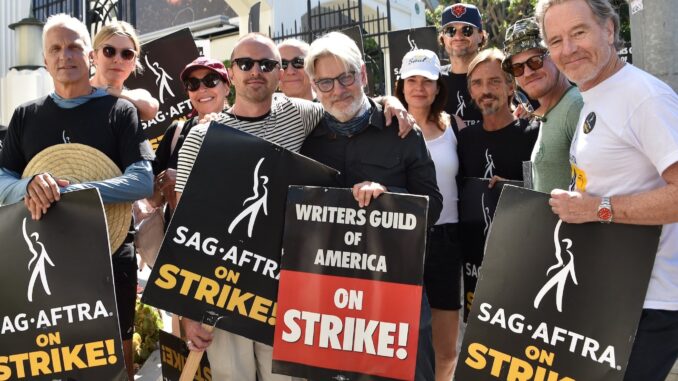
[ad_1]
The hottest place for coworkers to congregate lately is on the picket line.
From nurses to Hollywood actors to autoworkers, industry professionals are stepping out on their jobs to advocate for higher pay and benefits. So far in 2023, over 353,000 workers have gone on strike, the most in nearly two decades, according to Bloomberg Law data.
The widespread strikes have resulted in 4.1 million missed days of work so far in 2023, according to data from The Labor Department, per The Wall Street Journal.
The last time work stoppages occurred at a similar scale to today’s numbers was in 1997 when approximately 180,000 UPS workers went on strike. This year, the UPS teamsters embarked on a strike in June that concluded in a new contract agreement in August.
The largest number of work stoppages so far this year are by Hollywood actors, which account for about 160,000 of current work stoppages, according to the data.

Actors (L-R) Patrick Fabian, Rhea Seehorn, Norma Maldonado, Aaron Paul, writer Peter Gould, Betsy Brandt, Matt Jones, Charles Baker, Jesse Plemons and Bryan Cranston join members of the Screen Actors Guild (SAG-AFTRA) and WGA on the picket line in front of Sony Studios in Culver City, California, on August 29, 2023. Chris Delmas/AFP | Getty Images
Last week, United Auto Workers (UAW) members went on strike advocating for higher wages, making their strike the second largest work stoppage in recent history—UAW encompasses nearly 150,000 workers from General Motors, Ford, and Stellantis.
The strike, which began on September 15, calls for an immediate pay raise of 20% and subsequent 5% increases over four years. Negotiations are still ongoing as the strike has entered its fourth day.
However, despite the growing number of strikes, there are still 70% fewer strikes now in the U.S. compared to the early 1970s, according to the Economic Policy Institute.
Union membership has declined over the years due to various factors, including “right to work” laws (state-level regulations that prohibit employers and labor unions from requiring workers to join a union or pay union dues or fees as a condition of employment), as well as some companies being openly opposed to worker unions.
Still, approval of labor unions is at its highest level in almost 60 years, according to Gallup. In 2022, Gallup found that 71% of Americans approve of labor unions, the highest number since 1965.
[ad_2]
Source link
Leave a Reply